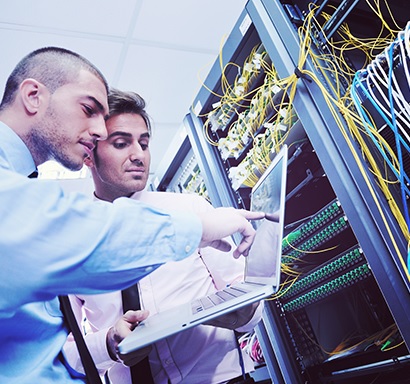
In a country like Australia, where bushfires, floods, and storms are part of the natural landscape – and cyber threats are on the rise – having a solid plan to keep your business running during tough times is essential. That’s where Disaster Recovery and Business Continuity come into play. While the two terms are often used interchangeably, they serve different yet equally critical purposes.
Let’s break down how these strategies help protect your operations, data, and customers when the unexpected hits.
What’s the Difference Between Disaster Recovery and Business Continuity?
What is Business Continuity (BC)?
Business Continuity (BC) is the big-picture strategy that ensures your critical operations can continue during a disruption – whether it’s a natural disaster, power outage, or IT failure. It includes communication protocols, alternative work arrangements (like working from home), supply chain resilience, and more.
Disaster Recovery (DR), on the other hand, is a more focused, technical plan that aims to restore IT systems, data, and infrastructure after a disruption. Think server restoration, data recovery, and network reconfiguration – it’s all about getting your systems back online quickly and securely.
| Aspect | Business Continuity | Disaster Recovery |
|---|---|---|
| Focus | Maintaining operations | Restoring IT infrastructure |
| Scope | Broad (includes people, processes, tech) | Technical (IT systems, applications, data) |
| Approach | Proactive | Reactive |
| Example | Relocating staff due to bushfire | Restoring servers after cyberattack |
Why It Matters More in Australia

Australia is prone to a wide range of disruptive events – from large-scale bushfires and floods to power outages and cyberattacks. These events can shut down operations and cost businesses thousands, if not millions, of dollars.
That’s why proactive planning is crucial. Having a Business Continuity Plan (BCP) and a Disaster Recovery Plan (DRP) ensures your organisation can bounce back fast – minimising downtime, protecting your assets, and keeping customers onside.
Key Components of a Disaster Recovery Plan (DRP)
To effectively recover from an IT disaster, your DRP should include:
Business Impact Analysis (BIA)
Identifies which systems and processes are essential, and the impact if they go offline.
Risk Assessment
Examines what threats could affect your systems – whether that’s bushfires, floods, or cyberattacks – and how vulnerable your organisation is.
Recovery Time Objective (RTO)
The maximum time you can afford for a system or application to be down.
Recovery Point Objective (RPO)
The maximum amount of data you can afford to lose (e.g. 4 hours of unsaved work).
Data Backup and Redundancy
Ensuring all vital data is regularly backed up and can be quickly restored.
Testing and Training
Your plan isn’t worth much if it hasn’t been tested. Regular testing and employee training are essential to ensure everything works when it matters.
Whether it’s cloud-based systems or hot desks at another site, having a Plan B for operations ensures you’re not stuck when disaster strikes.
Government Support for Disaster Recovery in Australia
The Australian Government provides a range of financial and recovery support through various programs, including:
Disaster Recovery Funding Arrangements (DRFA)
Joint state-federal funding to help communities recover after declared natural disasters.
Australian Government Disaster Recovery Payment (AGDRP)
One-off, non-means-tested payment for people affected by a major disaster.
Disaster Recovery Allowance (DRA)
Income support for people who’ve lost earnings due to a natural disaster.
Community-Led Recovery
Local councils and communities are encouraged to lead recovery efforts, supported by government resources.
Support Organisations
Australian Red Cross – Emergency support and relief.
Disaster Relief Australia – Veteran-led volunteer support for clean-up and rebuilding.
The Importance of Testing and Updating Your Plans

Even the best-laid plans become useless if they’re outdated. Technology evolves, business operations change, and new risks emerge. That’s why testing, reviewing, and updating your BCP and DRP regularly is essential.
Conduct annual mock disaster simulations.
Review roles and responsibilities.
Update contact lists and communication procedures.
Ensure all new systems and applications are covered.
Collaboration is Key
No business operates in a vacuum. Collaborating with your suppliers, emergency services, IT providers, and even competitors can strengthen your resilience. Sharing resources and knowledge can make all the difference when recovery time matters most.
Final Thoughts: Resilience Isn’t Just a Buzzword
In today’s climate, resilience is more than a nice-to-have – it’s a necessity. From managing bushfire risks to restoring critical data after a cyberattack, your ability to prepare, respond, and recover could mean the difference between survival and shutdown.
Invest in your Business Continuity Plan. Prioritise a strong Disaster Recovery strategy. Test, train, and adapt. Because in Australia, when disaster strikes – it often strikes hard and fast.
Conclusion
Disruptions will happen – it’s a matter of when, not if. By investing in both Disaster Recovery and Business Continuity, your business can withstand setbacks and maintain client trust, productivity, and profitability.
The key to mastering both lies in:
Understanding the distinct roles BC and DR play
Building detailed, realistic plans
Testing regularly and adjusting as your business evolves
In Australia’s ever-changing climate and digital landscape, resilience is not just a strategy – it’s your competitive advantage.
You may also like to know more about
- Comprehensive IT and Network Disaster Recovery Plan Checklist.
- 6 Steps to a Successful Network Disaster Recovery Plan.
- Explaining Disaster Recovery Plan Key Features.
- Crafting an Effective Disaster Recovery Plan: What Should Be Included?
Stay connected with EXCEED ICT
Stay connected with EXCEED ICT by joining our social networks (given at footer). Get the latest updates, news, and tips for enterprise device deployment. Follow us on Twitter, Facebook, and LinkedIn for the best enterprise device deployment solutions.
Help us to improve our enterprise by rating us on Google Maps. Your feedback and comments are valuable to us and will be used to make our services even better.
Frequently Asked Questions (FAQs)
How often should a disaster recovery plan be tested?
At least once a year, or whenever significant changes are made to your IT systems or business structure.
Is there government help available for small businesses after disasters?
Yes. Programs like the DRFA, AGDRP, and DRA offer financial and recovery assistance for eligible businesses.
What’s the main difference between BC and DR?
BC focuses on keeping your business running during a crisis. DR focuses on restoring IT systems after a disruption.


